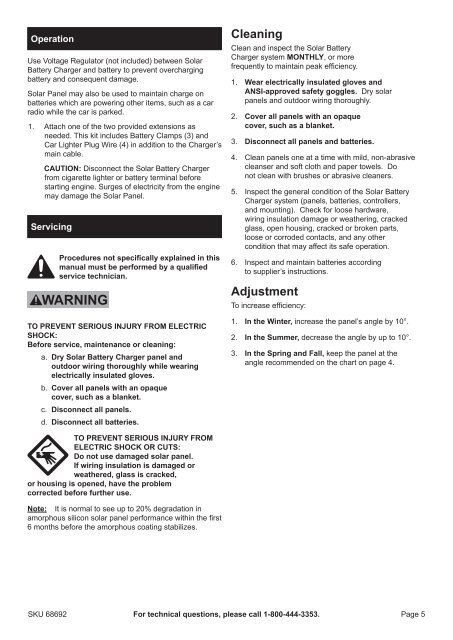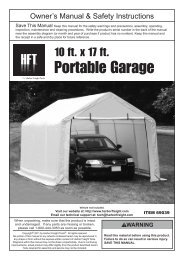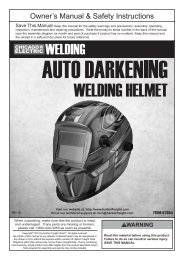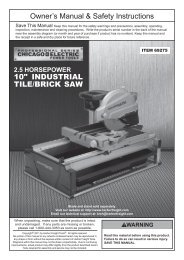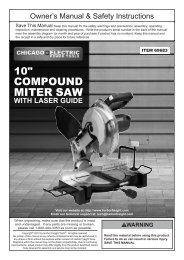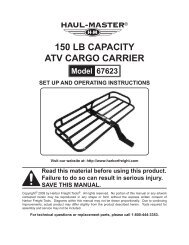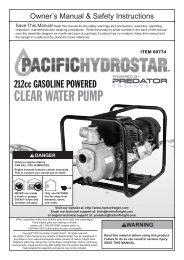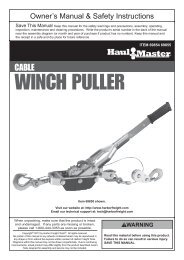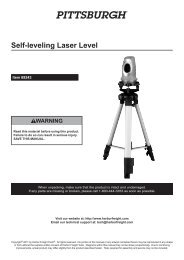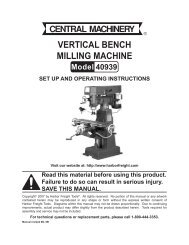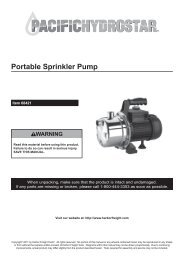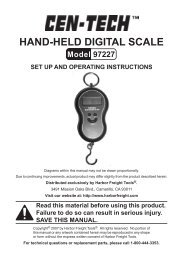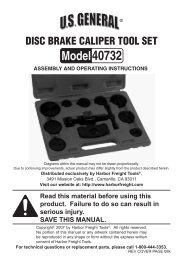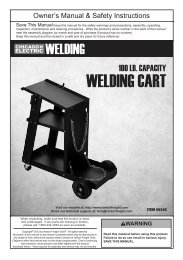1.5 Watt Solar Battery Charger - Harbor Freight Tools
1.5 Watt Solar Battery Charger - Harbor Freight Tools
1.5 Watt Solar Battery Charger - Harbor Freight Tools
You also want an ePaper? Increase the reach of your titles
YUMPU automatically turns print PDFs into web optimized ePapers that Google loves.
Operation<br />
Use Voltage Regulator (not included) between <strong>Solar</strong><br />
<strong>Battery</strong> <strong>Charger</strong> and battery to prevent overcharging<br />
battery and consequent damage.<br />
<strong>Solar</strong> Panel may also be used to maintain charge on<br />
batteries which are powering other items, such as a car<br />
radio while the car is parked.<br />
1. Attach one of the two provided extensions as<br />
needed. This kit includes <strong>Battery</strong> Clamps (3) and<br />
Car Lighter Plug Wire (4) in addition to the <strong>Charger</strong>’s<br />
main cable.<br />
CAUTION: Disconnect the <strong>Solar</strong> <strong>Battery</strong> <strong>Charger</strong><br />
from cigarette lighter or battery terminal before<br />
starting engine. Surges of electricity from the engine<br />
may damage the <strong>Solar</strong> Panel.<br />
Servicing<br />
Procedures not specifically explained in this<br />
manual must be performed by a qualified<br />
service technician.<br />
TO PREVENT SERIOUS INJURY FROM ELECTRIC<br />
SHOCK:<br />
Before service, maintenance or cleaning:<br />
a. Dry <strong>Solar</strong> <strong>Battery</strong> <strong>Charger</strong> panel and<br />
outdoor wiring thoroughly while wearing<br />
electrically insulated gloves.<br />
b. Cover all panels with an opaque<br />
cover, such as a blanket.<br />
c. Disconnect all panels.<br />
d. Disconnect all batteries.<br />
Cleaning<br />
Clean and inspect the <strong>Solar</strong> <strong>Battery</strong><br />
<strong>Charger</strong> system MONTHLY, or more<br />
frequently to maintain peak efficiency.<br />
1. Wear electrically insulated gloves and<br />
ANSI-approved safety goggles. Dry solar<br />
panels and outdoor wiring thoroughly.<br />
2. Cover all panels with an opaque<br />
cover, such as a blanket.<br />
3. Disconnect all panels and batteries.<br />
4. Clean panels one at a time with mild, non-abrasive<br />
cleanser and soft cloth and paper towels. Do<br />
not clean with brushes or abrasive cleaners.<br />
5. Inspect the general condition of the <strong>Solar</strong> <strong>Battery</strong><br />
<strong>Charger</strong> system (panels, batteries, controllers,<br />
and mounting). Check for loose hardware,<br />
wiring insulation damage or weathering, cracked<br />
glass, open housing, cracked or broken parts,<br />
loose or corroded contacts, and any other<br />
condition that may affect its safe operation.<br />
6. Inspect and maintain batteries according<br />
to supplier’s instructions.<br />
Adjustment<br />
To increase efficiency:<br />
1. In the Winter, increase the panel’s angle by 10°.<br />
2. In the Summer, decrease the angle by up to 10°.<br />
3. In the Spring and Fall, keep the panel at the<br />
angle recommended on the chart on page 4.<br />
TO PREVENT SERIOUS INJURY FROM<br />
ELECTRIC SHOCK OR CUTS:<br />
Do not use damaged solar panel.<br />
If wiring insulation is damaged or<br />
weathered, glass is cracked,<br />
or housing is opened, have the problem<br />
corrected before further use.<br />
Note: It is normal to see up to 20% degradation in<br />
amorphous silicon solar panel performance within the first<br />
6 months before the amorphous coating stabilizes.<br />
SKU 68692<br />
For technical questions, please call 1-800-444-3353.<br />
Page 5


